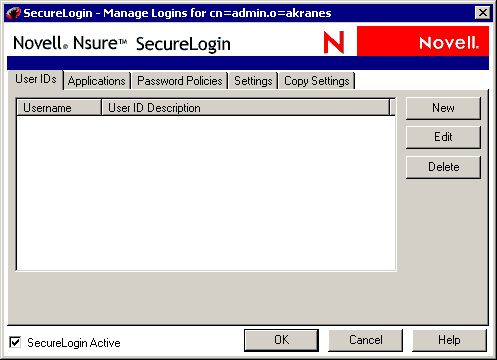Accessing Management Tools
You can manage Novell® SecureLogin at the workstation level or at the container or Organizational Unit (OU) level.
- The workstation level
Each workstation running SecureLogin has a SecureLogin client. This client can only alter the current user's SecureLogin information. However, changes made from SecureLogin's main window on the desktop override settings made at a container or organizational unit level.
For information on using the SecureLogin client, see the following:
- The Help system in the SecureLogin client
- The Nsure SecureLogin 3.51.2 User Guide
- The container or OU level
You can use the following management utilities:
- The SecureLogin snap-in to ConsoleOne®, installed on a workstation
To use ConsoleOne, select the eDirectoryTM option while installing SecureLogin.
- The Microsoft Management Console (MMC), which runs on a Windows server
MMC is installed with Active Directory. The snap-in to MMC is installed if you select the Active Directory option while installing SecureLogin.
- SecureLogin Manager (slmanager.exe)
SecureLogin Manager is useful if you have selected the LDAP option while installing SecureLogin.
- The SecureLogin snap-in to ConsoleOne®, installed on a workstation
You use the same processes at the workstation as from ConsoleOne or a Windows server. The same functionality exists in ConsoleOne, MMC, or SecureLogin Manager.
Accessing SecureLogin in ConsoleOne
Before you can access ConsoleOne, you must complete the following:
- Extend the eDirectory schema.
- Have ConsoleOne, the SecureLogin snap-in to ConsoleOne, and SecureLogin running on an administrative workstation in an eDirectory environment.
IMPORTANT: Install ConsoleOne and the SecureLogin snap-in files to the same directory. Otherwise, the SecureLogin snap-in files won't work.
- Install and run SecureLogin locally.
For information on these tasks see "Installing in Novell eDirectory Environments" in the Nsure SecureLogin 3.51.2 Installation Guide.
To access SecureLogin in ConsoleOne:
-
Run consoleone.exe.
Typically, this file is found in the \novell\consoleone\1.2\bin directory on a local drive. Place a shortcut on your desktop, then run ConsoleOne from there.
-
Select a Container or User object, then click Properties.
-
Click Novell SecureLogin.

The following figure illustrates options on SecureLogin's main page in ConsoleOne. You can add user IDs, enable applications for single sign-on, create password policies, manage settings, and copy settings.
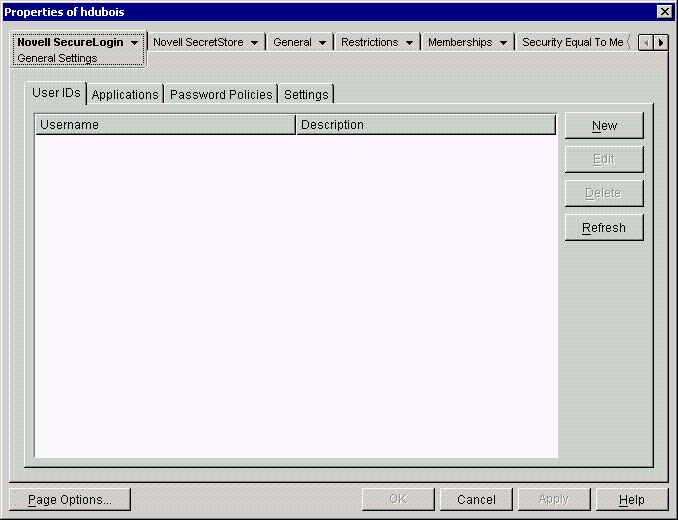
User IDs: Used to configure stored credentials that are linked to applications.
These credentials include usernames, passwords, or IP addresses. Because user IDs set at the container level apply to all users in the container, you can use this page to set up login access for a group of users where there is no requirement for individual user logins. See Managing User IDs.
Applications: Used to configure applications available for single sign-on.
This page displays applications that are enabled for single sign-on. You can manually add applications to the list or use the Add Applications Wizard. See Managing Applications.
Password Policies: Used to configure the settings and organizational rules for passwords.
See Managing Password Policies.
Settings: Used to configure users' SecureLogin environment, including the types of applications authorized for single sign-on.
See Managing Administrative and User Settings.
Copy Settings: Used to copy, export, and import settings, scripts, and user IDs across containers.
Accessing SecureLogin from MMC
Before you can access MMC, you must complete the following tasks:
- Install the Microsoft Windows 2000 or 2003 Server family operating systems (including Active Directory) on at least one domain controller in your network.
- Complete administrative tasks (including extending the Active Directory schema).
- Install SecureLogin for Active Directory.
- Have SecureLogin running on the workstation.
For information on these tasks, see "Installing in Active Directory Environments" in the Nsure SecureLogin 3.51.2 Installation Guide.
To access SecureLogin:
-
Click Start > Programs > Administrative Tools > Active Directory Users and Computers.
-
In the Active Directory Users and Computers pane, right-click an organizational unit (for example, Users).
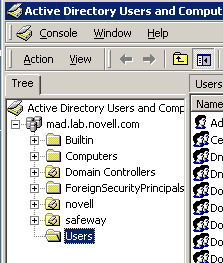
-
Click Properties, then click SecureLogin SSO.
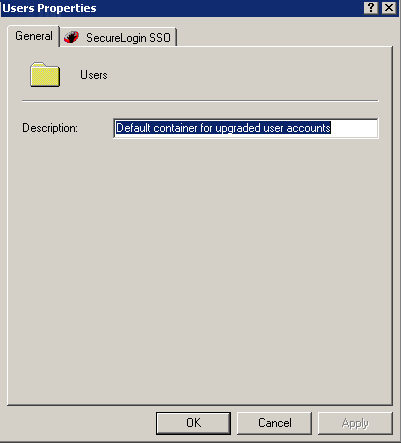
As the following figure illustrates, options on SecureLogin's main page in MMC enable you to add user IDs, enable applications for single sign-on, create password policies, manage settings, and copy settings.
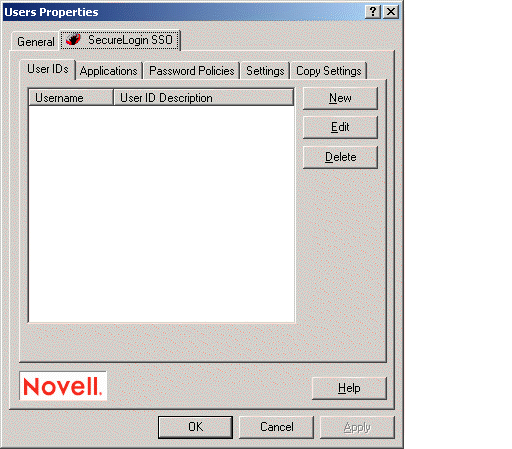
User IDs: Used to configure stored credentials that are linked to applications.
These credentials include usernames, passwords, or IP addresses. Because user IDs set at the container level apply to all users in the container, you can use this page to set up login access for a group of users where there is no requirement for individual user logins. See Managing User IDs.
Applications: Used to configure applications available for single sign-on.
This page displays applications that are enabled for single sign-on. You can manually add applications to the list or use the Add Applications Wizard. See Managing Applications.
Password Policies: Used to configure the settings and organizational rules for passwords.
See Managing Password Policies.
Settings: Used to configure users' SecureLogin environment, including the types of applications authorized for single sign-on.
See Managing Administrative and User Settings.
Copy Settings: Used to copy, export, and import settings, scripts, and user IDs across containers and domains.
Accessing SecureLogin from SecureLogin Manager
SecureLogin Manager doesn't run on Windows 9.x workstations.
To access SecureLogin Manager:
-
Run slmanager.exe.
This file is in the \securelogin\tools directory.
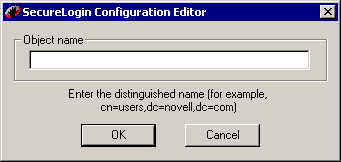
-
Log in as administrator.
In the Object Name text box, type a complete distinguished name. For LDAP and Active Directory, use LDAP conventions, as the figure in Step 1 illustrates.
For eDirectory, use eDirectory conventions. For example, type
cn=RDev.o=novell
The following figure illustrates SecureLogin Manager's main page:
